Shovel
A shovel is a tool for digging, lifting, and moving bulk materials, such as soil, coal, gravel, snow, sand, or ore.

Most shovels are hand tools consisting of a broad blade fixed to a medium-length handle. Shovel blades are usually made of sheet steel or hard plastics and are very strong. Shovel handles are usually made of wood (especially specific varieties such as ash or maple) or glass-reinforced plastic (fibreglass).
Hand shovel blades made of sheet steel usually have a folded seam or hem at the back to make a socket for the handle. This fold also commonly provides extra rigidity to the blade. The handles are usually riveted in place. A T-piece is commonly fitted to the end of the handle to aid grip and control where the shovel is designed for moving soil and heavy materials. These designs can all be easily mass-produced.
The term shovel also applies to larger excavating machines called power shovels, which serve the same purpose—digging, lifting, and moving material. Modern power shovels descend from steam shovels. Loaders and excavators (such as backhoes) perform similar work, etically speaking, but are not classified as shovels emically.
Hand shovels have been adapted for many different tasks and environments. They can be optimized for a single task or designed as cross-over or compromise multitaskers. They are very useful in agriculture.
History
In the Neolithic age and earlier, a large animal's scapula (shoulder blade) was often used as a crude shovel or spade.[1] It is via this connection between shoulder blades and digging blades that the words spatula and spade both have etymologic connection with scapulas.

The later invention of purpose-built shovels was a ground-breaking development. Manual shoveling, often in combination with picking, was the chief means of excavation in construction until mechanization via steam shovels and later hydraulic equipment (excavators such as backhoes and loaders) gradually replaced most manual shoveling. The same is also true of the history of mining and quarrying and of bulk materials handling in industries such as steelmaking and stevedoring. Railroad cars and cargo holds containing ore, coal, gravel, sand, or grains were often loaded and unloaded this way. These industries did not always rely exclusively on such work, but such work was a ubiquitous part of them. Until the 1950s, manual shoveling employed large numbers of workers. Groups of workers called 'labor gangs' were assigned to whatever digging or bulk materials handling was needed in any given week, and dozens or hundreds of workers with hand shovels would do the kind of rapid excavating or materials handling that today is usually accomplished with powered excavators and loaders operated by a few skilled operators. Thus the cost of labor, even when each individual worker was poorly paid, was a tremendous expense of operations. Productivity of the business was tied mostly to labor productivity. It still often is even today; but in the past it was even more so. In industrial and commercial materials handling, hand shoveling was later replaced not only with loaders and backhoes.
Given the central importance and cost of manual labour in industry in the late 19th and early 20th centuries, the "science of shoveling" was something of great interest to developers of scientific management such as Frederick Winslow Taylor.[2] Taylor, with his focus on time and motion study, took an interest in differentiating the many motions of manual labor to a far greater degree than others tended to. Managers might not care to analyze it (figuring that brute work is brute work, case closed), and workers might not care to analyze it in any way that encouraged management to take away the prerogative in craft work for the craftsman to decide the details of his methods. Taylor realized that failing to analyze shoveling practice represented a missed opportunity to discover or synthesize best practices for shoveling, which could achieve highest productivity (value for dollar spent). It was Taylor and colleagues in the 1890s through 1910s that greatly expanded the existing idea of varied shovel designs with different-sized scoops, one for each material, based on the material's density. Under scientific management, it was no longer acceptable to use the same shovel for shoveling brown coal one day and gravel the next. Taylor advocated the higher capital cost of maintaining two shovels as more than paying for itself through the increase in worker productivity that it would lead to, which would mean less money being spent on wages for each unit of shoveling work accomplished. Unfortunately, despite Taylor's valid insights about the possibility for applying science to manual labour (including shoveling and the lifting and carrying of heavy objects) and his valid insights about the inequality of talents between individuals, he did not really respect the human dignity of all workers, and tended to be contemptuous of people with low intelligence.[3]
The science of shoveling [that is, hand shoveling] has long since mostly faded out of commercial concern thanks to extensive mechanization, such as bulldozers and other equipment. Humans are once again mostly content to let one coal scoop handle various bulk materials of differing densities. But there is still a huge existing market for shovels as shovels are still required for precise manual work, where excavators cannot reach
During the Second industrial revolution around year 1900, the shovel gave way to heavy equipment such as excavators.
Types
| Image | Name (and synonyms if any) |
Description |
|---|---|---|
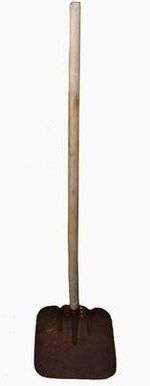 | coal shovel | Typically has a wide, flat blade with steeply turned sides, a flat face and a short D-shaped handle. Over the years, various sizes for different kinds or grades of coal have sometimes been used. |
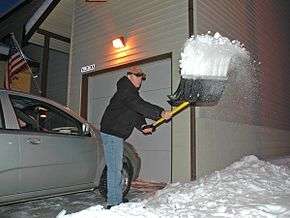 | snow shovel | Often has a very wide sideless blade that curves upward attached to a long handle. A variety of styles are available. Some are designed mostly for pushing the snow, others for lifting it. The blade can be metal or plastic, but the latter is used to offer a lighter tool that maintains its shape. Some have one or more wheels. |
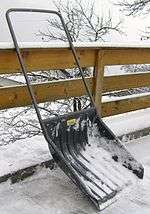 | snow sled shovel snow scoop sleigh shovel | large and deep hopper-like implement fitted with a wide handle and designed to scoop up a load of snow and slide it on any slippery surface to another location without lifting. |
| snow pusher | ||
| grain shovel barn shovel | Has a wide aluminium or plastic blade that is attached to a short hardwood handle with "D" top. This shovel has been designed to offer a lighter tool that does not damage the grain. Early models were made from timber. | |
| spoon shovel | A long handle with a small, oval, cupped, inclined blade at the end, used in excavating deep, narrow holes. Its name comes from its resemblance to a spoon. | |
| gardening trowel | A trowel in general is a small, single-hand implement for digging, scooping, spreading, or otherwise manipulating dirt or other bulk materials (such as mortar). In gardening and horticulture, they are useful in planting and potting for digging holes and breaking up clumps of soil. Gardening trowels typically have strong, narrow blades with sharp points. They are a [small] type of spade. | |
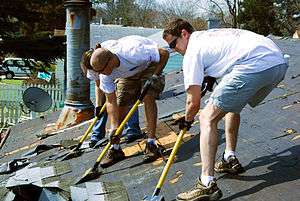 | roofing shovel | A specialized prying tool that evolved from use of spading forks and pitchforks to remove old roof shingles and underlayment as part of roof repair. |
| spade | A general category of shovels tailored to digging hard ground that must be broken with substantial force before it can be moved. Most spades have sharp or nearly sharp edges, often shaped as triangular points. (The typographical spade symbol, ♠, is a stylized icon derived from this idea.) Some spades lack triangular points but are fairly narrow. They are tailored to lawn cutting and to transplanting of bushes and small trees. In fact, their modern mechanized equivalent is also called a tree spade.
Some usage prescriptions prescribe that the words "spade" and "shovel" should be held in contradistinction (piercing and digging [spade] versus scooping and moving [shovel]). Natural language does not widely follow these prescriptions; it more often treats "spade" and "scoop" as contradistinguished subsets under "shovel". | |
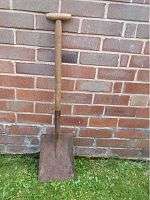 | square shovel | A general category of shovel that includes many types with a generally square outline (rather than being pointed like many spades are). But there is no rigorous, always-enforced distinction between square shovels and spades. |
| scoop | A general category of shovel that includes many types with a generally dished or cupped shape, and typically a fairly square edge, tailored to scooping up dirt or other materials that are already fairly loose and do not need the groundbreaking force of a spade's point. | |
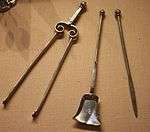 | fireplace shovel (see middle tool in image) | One of the fire irons used in a fireplace. It is used to tend to the ashes. |
| toy shovel | Common plaything on sandy beaches, in sandboxes, or in yards, gardens, lawns, and fields. | |
| trenching shovel trenching spade drain spade | Generally a long thin blade with pronounced upturned side flanges. Used for digging trenches. | |
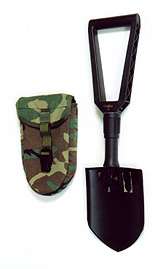 | entrenching tool | A smaller and sometimes collapsible shovel for creating and maintaining defensive fighting positions. |
See also
- Dustpan, a form of shovel
References
Bibliography
- Taylor, Frederick Winslow (1911), The Principles of Scientific Management, New York, NY, USA and London, UK: Harper & Brothers, LCCN 11010339, OCLC 233134. Also available from Project Gutenberg.CS1 maint: ref=harv (link)
External links
![]()